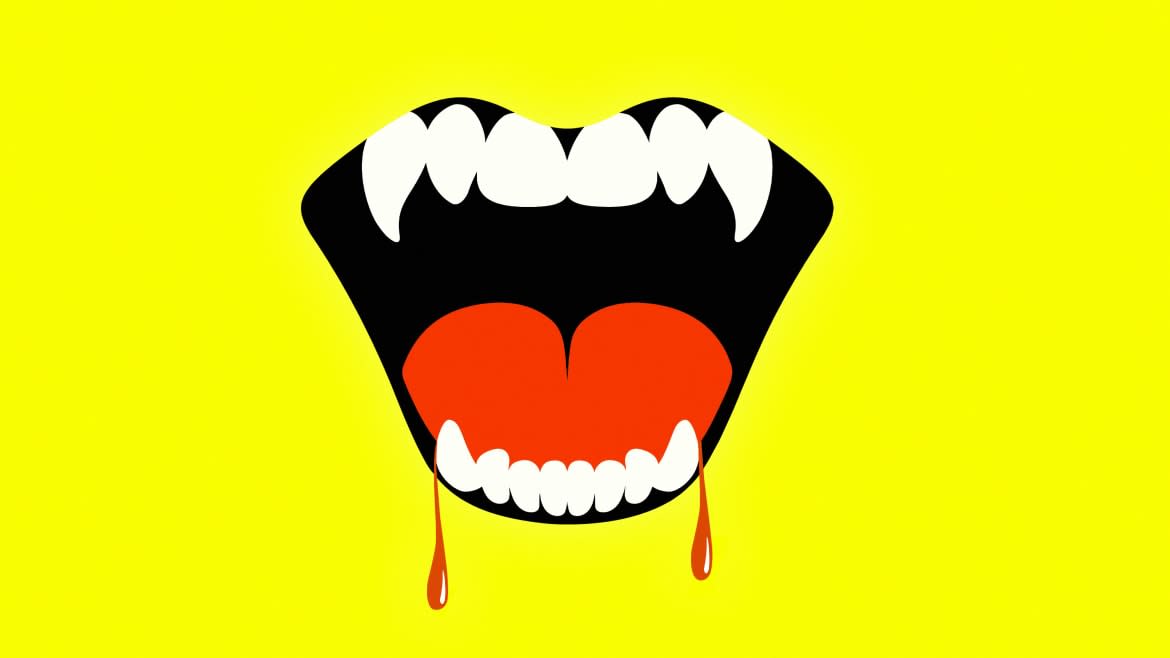This Blood Lust ‘Disorder’ Is Really an Old Prank Gone Wrong

In 2003, when Shane Chartres-Abbott was facing charges for raping and assaulting a woman in Australia, the 28-year-old put forth a patently absurd defense: he was a centuries-old vampire who craved human blood.
Some fans of pop psychology rushed to diagnose Chartres-Abbott. The mixing of blood and sexual urges, they argued, was totally in line with Renfield’s Syndrome, a mental illness that was not formally recognized within the Diagnostic and Statistical Manual of Mental Disorders (the principle guidebook for classifying mental illnesses in the U.S.), but that had been documented in academic psychological journals. The disorder was named after R.M. Renfield—a character in the 1897 Bram Stoker novel Dracula who slavishly served the titular monster, and the main character of the horror-comedy Renfield starring Nicholas Hoult, out this week.
The only problem was, Renfield’s Syndrome wasn’t real. Its “documentation” in scientific literature had originated as a joke—one that had grown far past anything its creator could ever imagine.
Nicolas Cage Stayed in Character as Dracula Even Behind the Scenes on ‘Renfield’ Set
In the early 1990s, Richard Noll was a psychologist who had left his job at a state hospital in New Jersey to try his hand at horror and monster-themed novels. As he prepared to defend his doctoral thesis in clinical psychology at New York’s New School for Social Research, he decided his next book—a work of nonfiction—would combine his two areas of expertise in order to shore up his professional bona fides. He bundled together some of the medical research he had done for his novels to examine the psychopathology that really lay behind creepy, real-life phenomena. He gave it the title Vampires, Werewolves and Demons: Twentieth Century Reports in the Psychiatric Literature.
At the time, the field of mental health care was still in the throes of a seismic shift. In 1980, the third edition of the DSM had radically changed how mental illnesses were classified and organized. Trained in Freudian psychoanalysis, Noll felt the DSM III was “definitely an improvement over the old Freudian, psychoanalytic way of doing things.” But he found himself critical of how the new manual reduced highly complex illnesses to bullet points and checklists.
“I had a realization that in the DSM, there’s over 500 disorders, and there’s only about 10 of them that have any real biological findings,” Noll, now a professor of clinical psychology and the history of medicine at DeSales University, told The Daily Beast. “You know, things like schizophrenia, bipolar I disorder, autism, panic disorder, OCD, we have absolutely definite biological findings associated with those. And then there’s a few others, but hundreds of the other ones are basically just social constructions.”

Richard Noll.
With those critiques swimming through his head as he typed away at his manuscript late one night, he was struck by a sudden urge: What if he could screw with the eggheads?
“I’d been writing for hours, and I was a little loopy and I thought, you know, there’s a certain way you can read these case histories and abstract from them and create a DSM disorder,” he said.
A longtime admirer of Stoker’s novel, Noll had particularly developed a fondness for the character Dr. Abraham Van Helsing, the multi-talented physician, scientist and philosopher who has become synonymous with vampire killing. To Noll, Van Helsing’s considerable intellectual gifts—his ability to see what others did not see—was something to aspire to in his own professional life. (His own Transylvanian heritage on his father’s side might also have played a role in his relationship to the source material).
Noll published the book in 1992. Tucked into the book were just a few paragraphs calling on the need to classify a brand-new diagnosis, based on case studies Noll had dug up from the archives in which patients would develop fixations with consuming live animals or blood (either their own or from another person), while also becoming sexually aroused. Noll suggested the condition be called Renfield’s Syndrome, named after Dracula’s tragic familiar in the novel. In the story, Renfield was cursed to live by consuming flies and spiders to absorb their energy, giving readers a more humanized, grounded version of the same compulsions that drove the titular vampire.
Noll was looking to satirize the rush among psychiatrists at the time to invent new clinical classifications for strange behaviors—and inventing a new one inspired by vampirism felt both funny as well as identifiable. In a 2013 public presentation at Penn State, Noll called the giggly moment where he came up with Renfield’s Syndrome “my Van Helsing moment.”
“I began to think of all the new DSM-speak and biobabble we were all learning to use at that time, and I thought how much fun it would be to create a parody of a DSM-III mental disorder based on the case of Renfield,” he told the audience.
“Little did I know, at that moment I had created a monster.”
In Noll’s joke description, Renfield’s Syndrome was defined as involving a traumatic childhood incident involving blood. While clinical vampirism had already been coined as a term in psychiatric literature, Noll elevated the concept with Renfield’s Syndrome, explaining that the inciting incident would lead sufferers to associate blood with an excitement that would eventually evolve to include a sexual component.
Naming the fictional syndrome after Dracula “would have been the sexier option” said Noll, but he felt Renfield’s humanity made him a better fit. (Noll is particularly a fan of Tom Waits’ shuffling, shambling portrayal of Renfield in the 1992 adaptation of Stoker’s novel, starring Keanu Reeves but does plan to check out Hoult’s take on the character once it’s released).
While there have been recorded cases of patients claiming to crave blood, they often suffer from other, more common disorders like bulimia or schizophrenia. To Noll, the rare case of someone wanting to drink human blood isn’t indicative of an actual syndrome, but of something much simpler.
“I'm sorry to say, and this isn’t very clinical or very sophisticated or academic, but some people are just fucking nuts,” he stated bluntly. “Not everything can be categorized.”
While the book sold fairly well, Noll didn’t think his late-night gag would ever bear anything notable. That is until 1994, when a producer from NBC called, saying the network was planning a Halloween segment on the illness and wanted him to appear as an expert.
George Conway Breaks Down Trump’s Deep ‘Mental Disorder’
Noll declined, but the segment ran anyway. Soon, Renfield’s Syndrome would become something of a mainstay in bad television: both CSI and Criminal Minds have had episodes featuring characters who are said to suffer from the disorder.
Exhausted TV writers are one thing to worry about, but Noll’s monster didn’t stop there. Fellow academics—you know, the ones who spend years of their life engaging with scientific findings and peer-reviewed data—began to jump on the Renfield’s Syndrome bandwagon. For decades, Noll sat back in amusement as his fictional mental illness began racking up citations in peer-reviewed journals. A Google Scholar search turns up over a dozen results for Renfield’s Syndrome, including a 2010 paper in Annals of the American Psychotherapy Association purporting to include a case study; and the following year, an article in the Journal of the History of the Neurosciences which purports to lay out a proper working definition of the disorder.
That an offhand joke was being cited in scholarly papers without a hint of irony surprised Noll. But bad information going viral was not new to psychiatry. This is a branch of medicine whose most famous practitioner, Sigmund Freud, recommended copious amounts of cocaine as a treatment.
Virtual Reality Could Completely Transform Mental Health—if We’re Ready
In fact, this would not even be the first instance of Noll playing some role in the spread of pseudo-psychiatric information (although he would stay on the right side of things). At roughly the same time he was concocting Renfield's Syndrome, the U.S. was awash in a fearful mania around supposedly traumatized children who had suffered abuse at the hands of devil worshippers. Noll emerged as one of the leading voices urging restraint when it came to believing these outlandish stories, even as some people suffered life-altering consequences for crimes they didn’t commit.
If Satanic cabals sound familiar, a very similar belief system is at the core of many QAnon conspiracy theories, a development that worries Noll, particularly as many in the mental health profession continue to believe in recovered memories.
Still, even as the joke has illustrated some of the major flaws in how concepts, no matter how faulty or even flat-out made-up, can find life in academic circles, Noll still sees the humor in his undying joke. When asked if his joke is still relevant in 2023, he points out that while he never published an official rebuttal of those who unironically invoke Renfield’s Syndrome, he has confessed in public speeches.
“It gives me endless pleasure to see Renfield’s Syndrome mentioned on the web,” he said. “I mean, I made it clear [in a] presentation, where I outed myself, back in 2013 at Penn State. I gave a little Halloween presentation there where I basically debunked myself, and the concept of Renfield’s Syndrome, so, yeah, it is.”
Got a tip? Send it to The Daily Beast here
Get the Daily Beast's biggest scoops and scandals delivered right to your inbox. Sign up now.
Stay informed and gain unlimited access to the Daily Beast's unmatched reporting. Subscribe now.

